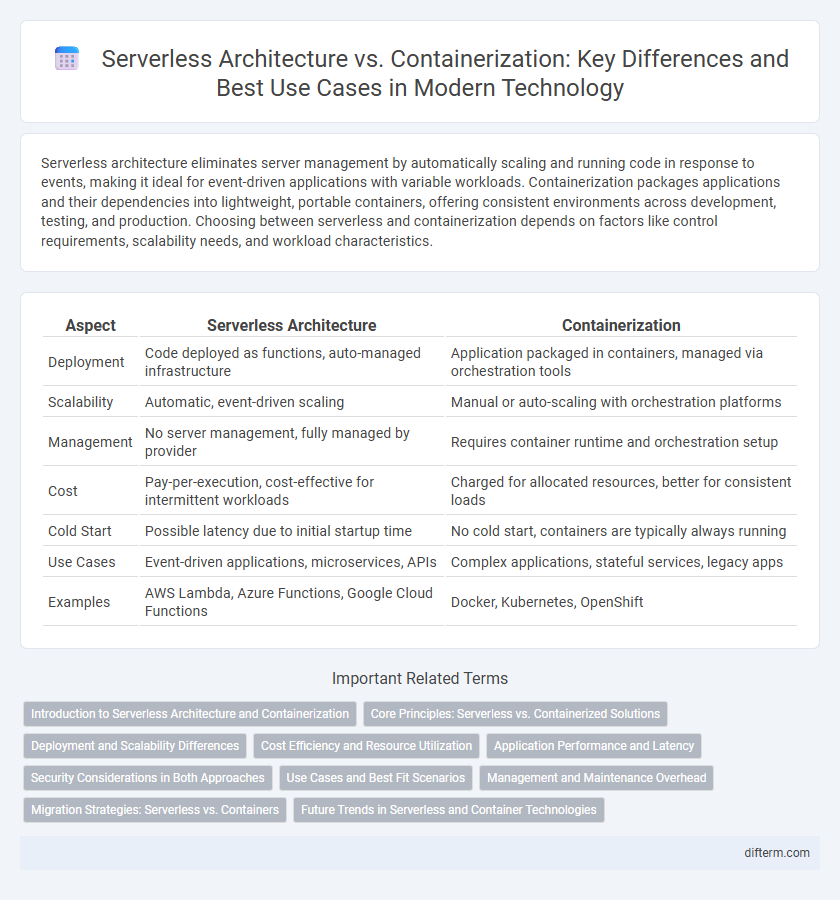Serverless architecture eliminates server management by automatically scaling and running code in response to events, making it ideal for event-driven applications with variable workloads. Containerization packages applications and their dependencies into lightweight, portable containers, offering consistent environments across development, testing, and production. Choosing between serverless and containerization depends on factors like control requirements, scalability needs, and workload characteristics.
Table of Comparison
| Aspect | Serverless Architecture | Containerization |
|---|---|---|
| Deployment | Code deployed as functions, auto-managed infrastructure | Application packaged in containers, managed via orchestration tools |
| Scalability | Automatic, event-driven scaling | Manual or auto-scaling with orchestration platforms |
| Management | No server management, fully managed by provider | Requires container runtime and orchestration setup |
| Cost | Pay-per-execution, cost-effective for intermittent workloads | Charged for allocated resources, better for consistent loads |
| Cold Start | Possible latency due to initial startup time | No cold start, containers are typically always running |
| Use Cases | Event-driven applications, microservices, APIs | Complex applications, stateful services, legacy apps |
| Examples | AWS Lambda, Azure Functions, Google Cloud Functions | Docker, Kubernetes, OpenShift |
Introduction to Serverless Architecture and Containerization
Serverless architecture enables developers to deploy applications without managing underlying infrastructure, automatically scaling resources based on demand and reducing operational overhead. Containerization packages applications and their dependencies into isolated, lightweight units that run consistently across various environments, simplifying deployment and scaling. Both technologies streamline cloud-native application development but differ in abstraction levels and management responsibilities.
Core Principles: Serverless vs. Containerized Solutions
Serverless architecture abstracts infrastructure management by automatically scaling functions based on demand and charging only for actual execution time, enabling rapid development with minimal operational overhead. Containerization packages applications and their dependencies into lightweight, portable units that run consistently across environments, providing granular control over resource allocation and lifecycle management. Core principles emphasize serverless's event-driven, stateless execution model versus containerization's focus on encapsulated, stateful services with explicit orchestration.
Deployment and Scalability Differences
Serverless architecture enables automatic scaling by dynamically allocating resources based on demand without managing underlying infrastructure, which simplifies deployment processes and reduces operational overhead. Containerization requires managing container orchestration platforms like Kubernetes to scale applications, offering more control over resource allocation and deployment environment consistency. Deployment in serverless is event-driven with near-instantaneous scaling, whereas containerization provides predictable, customizable scaling suited for complex, long-running applications.
Cost Efficiency and Resource Utilization
Serverless architecture reduces costs by eliminating the need for server management and charging strictly based on actual function execution time, optimizing resource utilization with automatic scaling. Containerization offers efficient resource allocation through lightweight, consistent environments that maximize hardware usage but requires management of orchestration and infrastructure. Choosing between the two depends on workload patterns; serverless excels in variable, event-driven applications, while containers suit steady, intensive tasks needing fine-grained control.
Application Performance and Latency
Serverless architecture minimizes application latency by automatically scaling resources in response to demand, enabling fast execution without managing underlying infrastructure. Containerization offers consistent performance by packaging applications with their dependencies, reducing environment-related latency but requiring manual scaling and orchestration. Application performance in serverless can fluctuate due to cold starts, whereas containers provide predictable latency through persistent runtime environments.
Security Considerations in Both Approaches
Serverless architecture minimizes attack surface by abstracting server management, but introduces risks related to function-level permissions and event injection. Containerization offers more control over the environment with isolated namespaces and resource limits, yet requires diligent patching and monitoring to prevent container escape vulnerabilities. Both approaches demand robust identity and access management (IAM) practices and continuous security assessments to mitigate potential threats.
Use Cases and Best Fit Scenarios
Serverless architecture excels in event-driven applications, microservices, and variable workloads where automatic scaling and reduced operational management are priorities. Containerization is best suited for complex, stateful applications requiring consistent runtime environments, portability across hybrid clouds, and granular resource control. Organizations leveraging continuous integration and delivery pipelines benefit from containers, while serverless is ideal for rapid development and cost-efficient execution of intermittent functions.
Management and Maintenance Overhead
Serverless architecture significantly reduces management and maintenance overhead by abstracting infrastructure concerns, allowing developers to focus solely on code deployment and scaling without server provisioning. Containerization requires ongoing management of container orchestration platforms such as Kubernetes, including updates, monitoring, and scaling, which increases operational complexity. Serverless solutions eliminate the need for managing underlying infrastructure, whereas containerization offers more control but demands higher administrative effort to maintain system stability.
Migration Strategies: Serverless vs. Containers
Migration strategies for serverless architecture emphasize minimal infrastructure management by deploying functions directly to cloud services such as AWS Lambda or Azure Functions, enabling rapid scalability and reduced operational overhead. Containerization migration involves packaging applications and dependencies into Docker containers, facilitating consistent environments across development, testing, and production with tools like Kubernetes for orchestration. Selecting serverless suits event-driven, stateless applications, while containerization supports complex, stateful workloads requiring greater control over runtime environments.
Future Trends in Serverless and Container Technologies
Serverless architecture is evolving with enhanced event-driven capabilities and improved cold start latency, enabling more efficient resource utilization and scalability compared to traditional containerization. Container technologies are increasingly integrating with serverless platforms through Kubernetes-native serverless frameworks, promoting flexibility and hybrid deployment models. Future trends indicate a convergence where serverless and containerization complement each other, supporting microservices and edge computing with greater automation and observability.
Serverless architecture vs Containerization Infographic

 difterm.com
difterm.com